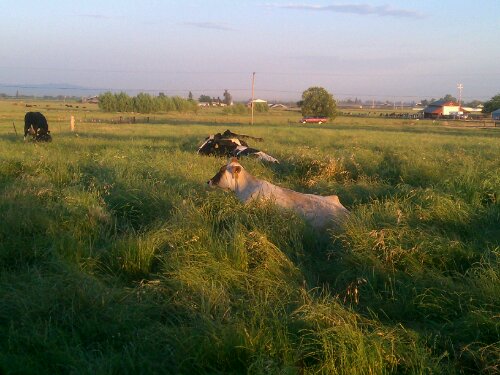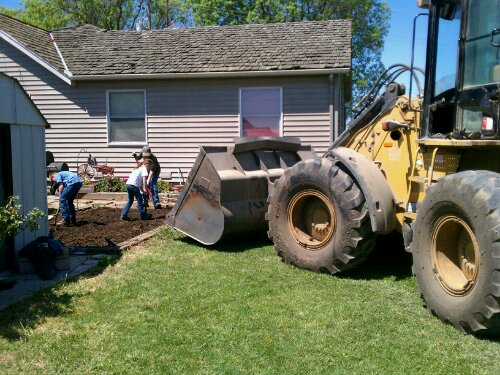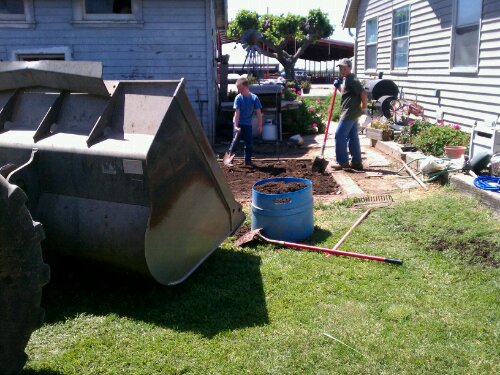Ray-Lin Dairy
Central Valley
Peek a Boo Sun

Beautiful sunrise and one reason we enjoy working with the cows because we can witness natures grandeur first hand.
Awesome sunrise taken from one of our barns.
Lazy Summer Morning
Here is a cow picture for Wordless Wednesday.

A few of our cows enjoying the cool morning before a hot summer day here in Central California.
These cows were just moved into this pasture yesterday and are relaxing in the grass. With all the late rains we had here in the Central Valley and now the heat the grass is growing very quickly in the pasture. these cows need to get up and get to work eating it down!
Posted from WordPress for Android
Related articles
- Cows play in sprinklers? Wordless Wednesday (raylindairy.wordpress.com)
Planting the garden – Farm style!
Just remembered I had this post saved as a draft and never published it, silly me!
Here are some pictures of how we prepped the soil (using a little overkill) for our garden.

We like to go BIG on the farm!
We use our loader to get a scoop of the compost we make from the manure our cows leave behind.

Adding our own compost to the garden.
We mixed the compost into the soil to add vital nutrients that allows our vegetables to grow.


Ready to plant!
The finished product!
Related articles
- What do you do with all that cow poop? (Ray-Lin Dairy)
- Simple Compost Tea (autumnrosecottage.wordpress.com)
- The recipe for a ripe batch of manure tea (sfgate.com)
Dairy cares? Environment
Here is a quick update about dairies in California’s Central valley and their progress with environmental regulations
Dairy Cares Report
February 2011
www.dairycares.com

Working together, we can continue to make our communities and state a better place to live and raise our families.
Myths vs. facts: Much progress made in dairy water quality protection efforts
It is an indisputable fact that in the past four years, California dairy families have invested more than $150 million in landmark water quality protection efforts. And here are a few other such facts:
- California’s Central Valley has the most comprehensive dairy groundwater quality protection regulations in the nation;
- Individual dairy families have spent thousands of hours since 2007 taking specific measures, every day on every dairy, to enhance water quality protection and stewardship of the soil, land and other natural resources; and
- Dairies have done all this while enduring a historic struggle to survive, through a global economic downturn that drove more than 200 of the state’s dairies out of business.
California dairy families deserve recognition and credit for their efforts to protect groundwater. Dairy farmers here are leading efforts in our state and across the nation to use best practices that will help ensure sustainable food production in the Central Valley for centuries to come.
Strangely, dairy families were recently rewarded for their efforts with a different variety of recognition, one that leads cynics to observe: “No good deed goes unpunished.” Food & Water Watch (FWW), a national organization whose stated goal is to “ensure the food, water and fish we consume is safe, accessible and sustainable,” last week published a report condemning the efforts of California water quality regulators and dairy operators. Acknowledging that “dairy waste is by no means to the sole source of groundwater contamination,” and that dairy regulation has only recently been launched, FWW nevertheless pronounced efforts to date a failure.
FWW’s central premise – that poor quality water in many Central Valley wells points to the failure of dairy regulatory efforts – is simply dead wrong. Poor groundwater quality in our valley wells is a legacy problem that has been developing in the Central Valley for many decades, indeed since irrigated agriculture and use of fertilizers began in the valley more than 150 years ago. In fact, many of the most serious contributors to poor well water quality in valley communities, such as arsenic and boron, occur naturally in the soil and are not produced by agriculture or dairies. There are also other man-made sources of water pollution, including rural septic systems, urban and industrial sources, and the list goes on.
Dairy families are doing their part. In 2007, acknowledging that all must share the effort to protect and improve our water quality, dairy families stepped forward to work with regulators toward meeting the challenge of continued, long-term sustainable farming in our valley. They have made tremendous progress in just four years, including:
- Conducting regular sampling of all wells on every dairy to monitor water quality;
- Controlling all applications of manure and fertilizers to crops through a “nutrient management plan,” prepared by a certified professional to balance the fertilizer needs of the plants and protect groundwater from excess fertilizer;
- Making sure an engineer has inspected and signed off on any manure storage structures to ensure they are structurally sound and protected against floods; and
- Working with regulatory enforcement staff to ensure that these improvements are continuous, properly documented and enforceable, through submittal of reports and lab results, other records, and routine inspections.
But apparently, significant progress isn’t enough. FWW seems to be suggesting that only four years into implementing a complex, tough and expensive regulation, all Central Valley groundwater quality challenges should already be solved. Never mind that the current state of valley groundwater developed slowly over more than a century (in some cases, over millennia) and that we have barely allowed time for the newly implemented regulations to begin to reverse the trend. And never mind that regulating dairies alone won’t solve the problem. Like other environmental impacts, groundwater impacts come from myriad natural and man-made sources – and for many of these other causes, little has yet been attempted to address the problem.
In a final twist that is either remarkably unfair or grossly uninformed, FWW points to larger “industrialized” dairies as the source of the problem. Using the time-tested argument that “big must always be bad,” and using the pejorative term “industrialized” to equate larger farms with heartless factories, FWW suggests the government must act to make dairies smaller. Without a shred of evidence to back their claims, they suggest larger dairies have a disproportionate environmental impact. This sort of misinformation is not just wrong, but dangerously misleading. It suggests that we magically achieve environmental sustainability through size alone. In fact, best practices such as those described above – proper fertilizer application, and sound engineering and management – are the real key for sustainable dairies large or small. We should recognize, not criticize, the significant investment of many larger dairies in state-of-the-art environmental management systems, often to meet California-specific requirements.
Regardless of size, another indisputable fact is that 99 percent of California dairies are owned and cared for by families in the business for generations, families who understand and share the core values of protecting land, water and air resources, because they depend on them to survive and prosper. FWW can try to paint these people as uncaring, but that’s wrong and unfair.
FWW claims their goal is food and water that is “safe, sustainable and accessible” for all. Dairy families deserve to be judged by their actions, not FWW’s skewed, misinformed words. While FWW criticizes, California dairy families are actually doing what it takes to protect groundwater while producing a safe, sustainable, nutritious and affordable food supply for millions of Americans.
